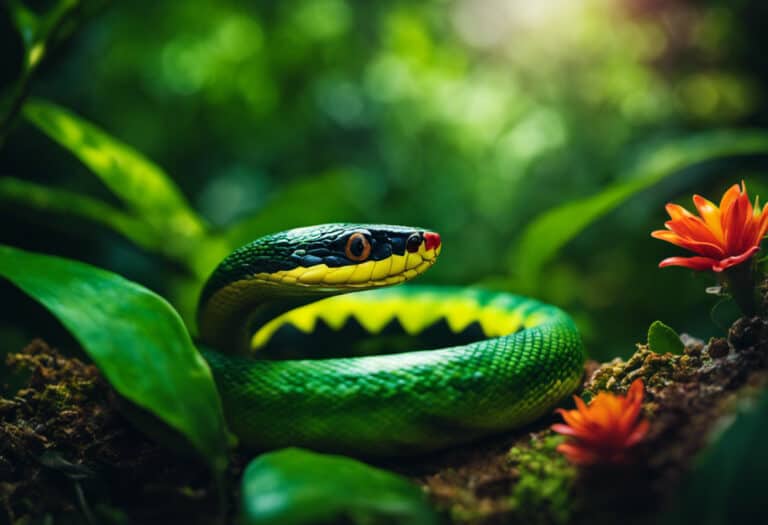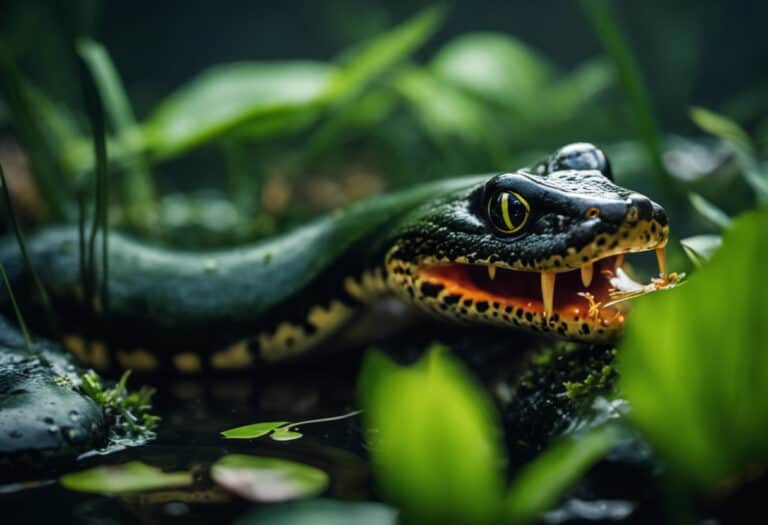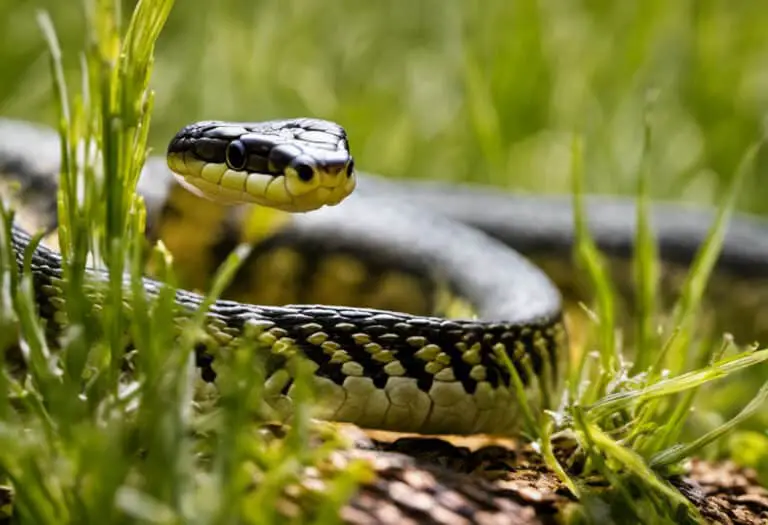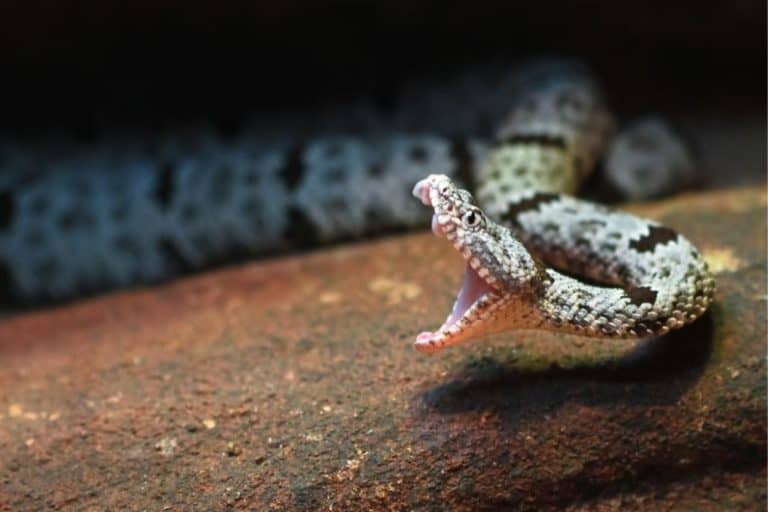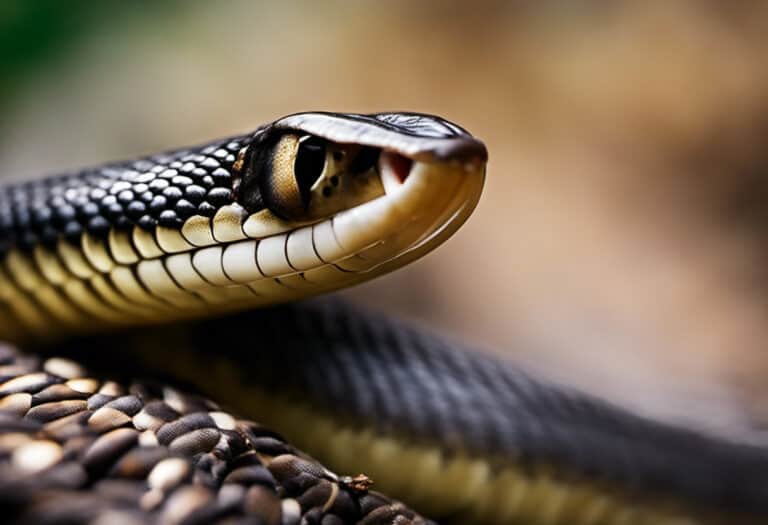Difference Between Venomous and Non Venomous Snakes
Curious about the difference between venomous and non-venomous snakes? Look no further! In this article, we’ll explore the distinct characteristics that set these two types apart.
From physical features to behaviors, understanding these differences is crucial for your safety and knowledge. Venomous snakes have fangs with venom, while non-venomous snakes have hooked teeth. Their heads also differ, with venomous snakes having triangular heads.
Both exhibit aggressive behavior and rely on sunlight to regulate their body temperature.
Expand your knowledge and discover more fascinating details about snakes!
Key Takeaways
- Venomous snakes have fangs that hold venom, while non-venomous snakes have small hooked teeth.
- Venomous snakes have triangular and wide heads, while non-venomous snakes have rounded heads.
- Venomous snakes have vertical or elliptical pupils, while non-venomous snakes have round pupils.
- Venomous snakes have pits around their nostrils and eyes, while non-venomous snakes do not have pits.
Physical Characteristics
Venomous snakes have triangular and wide heads, while non-venomous snakes have rounded heads. This distinction in head shape is crucial when identifying venomous snakes.
Additionally, venomous snakes have vertical or elliptical pupils, whereas non-venomous snakes have round pupils. The pupil shape can provide valuable information about a snake’s venom production capabilities.
Venomous snakes also possess pits around their nostrils and eyes, which aid in heat detection and prey location. These pits are absent in non-venomous snakes.
By understanding these physical characteristics, you can better identify and differentiate between venomous and non-venomous snakes. Remember, the key indicators are head shape, pupil shape, and the presence of pits.
Stay informed and be aware of the potential dangers associated with venomous snakes, ensuring your freedom and safety in snake-inhabited areas.
Pupil Shape
The shape of a snake’s pupil can provide valuable information about its venomous nature. Venomous snakes typically have vertical or elliptical pupils, while non-venomous snakes have round pupils.
This distinction in pupil shape is an evolutionary advantage for venomous snakes, as it allows them to control the amount of light entering their eyes and enhances their ability to accurately strike at prey.
However, it’s important to note that there may be exceptions to this rule, as certain non-venomous snake species may exhibit vertical or elliptical pupils.
Pupil Shape Indicates Venom
When identifying snakes, you can determine if they’re venomous or non-venomous based on the shape of their pupils. Venomous snakes typically have vertical or elliptical pupils, while non-venomous snakes have round pupils.
This distinction in pupil shape is crucial for survival and has evolved as an advantage for venomous snakes. The vertical or elliptical shape allows for better depth perception and helps them accurately strike and capture prey.
However, it’s important to note that there are exceptions to this rule. Some non-venomous snakes, such as the Asian vine snake, have vertical pupils.
On the other hand, some venomous snakes, like the African puff adder, have round pupils. Therefore, while pupil shape can be a useful clue, it shouldn’t be the sole factor in determining a snake’s venomous nature.
Evolutionary Advantage of Pupils
You can understand the evolutionary advantage of different pupil shapes in snakes by considering their hunting behavior and prey capture techniques.
The shape of a snake’s pupil plays a crucial role in its ability to effectively hunt and capture prey. Most snakes have round pupils, which allow for a wide field of vision and excellent depth perception. This is beneficial for snakes that primarily hunt during the day and rely on visual cues to locate their prey.
However, there are exceptions to this rule. Some snakes, such as the venomous pit vipers, have evolved vertical or elliptical pupils. These pupils allow for precise depth perception, which is advantageous for snakes that hunt in low-light conditions or ambush their prey.
The vertical or elliptical shape helps these snakes accurately judge the distance between themselves and their prey, increasing their chances of a successful strike. This adaptation provides them with a significant evolutionary advantage in their hunting strategies.
Any Exceptions to Rule?
There are a few snake species that deviate from the norm and have different pupil shapes. These exceptions to the rule can be intriguing and add to the beauty and diversity of the snake world.
Some non-venomous snakes, such as the tree boa and the cat snake, have vertical pupils instead of the usual round ones. This unique feature sets them apart and adds to their mystique.
Additionally, non-venomous snakes can display a wide range of markings and coloration. From the vibrant red and black patterns of the coral snake to the bold yellow and black stripes of the garter snake, these unique markings serve as a form of defense or camouflage.
Head Shape
The head shape is a key distinguishing feature between venomous and non-venomous snakes. Venomous snakes have triangular and wide heads, while non-venomous snakes have rounded heads. This difference in head shape is an evolutionary advantage for venomous snakes.
The triangular shape allows for the accommodation of venom glands, which are located behind the eyes. The wide head provides space for the muscles required to deliver venom through the fangs.
In addition to the head shape, the tooth structure in venomous snakes is also unique. Venomous snakes have long, hollow fangs that are used to inject venom into their prey. These fangs are located in the front of the mouth and can be retractable.
Non-venomous snakes, on the other hand, have small hooked teeth that are used to capture and constrict their prey.
The differences in head shape and tooth structure between venomous and non-venomous snakes are essential for understanding their distinct capabilities and behaviors.
Tooth Structure
Venomous snakes have long, hollow fangs, while non-venomous snakes have small hooked teeth. The evolutionary advantage of triangular fangs is that they allow venomous snakes to inject their venom more effectively into their prey.
The shape and structure of these fangs enable them to penetrate deep into the prey’s flesh, ensuring that the venom reaches its target. Venom is a powerful weapon for venomous snakes, as it affects their prey in various ways.
The venom can immobilize the prey, cause paralysis, or even initiate the breakdown of the prey’s tissues. This allows the snake to subdue and eventually consume its prey.
The venomous snake’s tooth structure and venom play a crucial role in the hunting and survival of these fascinating creatures.
Coloration and Markings
You can easily distinguish venomous snakes from non-venomous snakes by their vibrant colors and unique markings. The evolutionary advantage of coloration in venomous snakes is twofold.
First, it serves as a warning to potential predators, signaling that they possess venom and should be avoided. Second, it acts as camouflage, helping them blend into their natural habitats and ambush prey.
However, there are exceptions to these coloration patterns. Some venomous snakes, like the coral snake, have bright red, yellow, and black bands that mimic the coloration of non-venomous snakes. This is an example of Batesian mimicry, where a harmless species imitates the appearance of a harmful one.
Conversely, some non-venomous snakes, like the milk snake, mimic the coloration of venomous snakes, gaining protection from potential predators.
Coloration in snakes is a fascinating adaptation that has evolved to aid in survival and is a testament to the diversity and complexity of the natural world.
Pit Organs
Pit organs are specialized sensory structures found in venomous snakes, such as rattlesnakes and vipers. These unique organs are located on either side of the snake’s head, between the nostril and the eye.
They’re heat-sensitive and help the snake detect the infrared radiation emitted by warm-blooded prey, allowing for precise targeting and striking.
Purpose of Pit Organs
The purpose of pit organs in certain snake species is to detect infrared radiation, allowing them to locate warm-blooded prey even in the dark.
These fascinating organs are found in pit vipers, such as rattlesnakes and copperheads, and are located on either side of their heads, between the nostril and the eye.
Pit organs function by detecting the heat emitted by potential prey, which appears as infrared radiation. This ability to sense heat is crucial for these snakes, as it allows them to hunt efficiently, even in low-light conditions.
The pit organs serve as an incredible tool, providing snakes with a distinct advantage over their prey. In addition to their remarkable function, the significance of coloration and markings can’t be ignored.
Many venomous snakes have vibrant colors and distinctive patterns, which serve as a warning to potential predators. These markings often act as a visual deterrent, conveying the message that the snake is dangerous and should be avoided.
The combination of pit organs and vivid coloration makes venomous snakes highly effective hunters and formidable adversaries in the animal kingdom.
Function of Pit Organs
Did you know that pit organs in certain snake species allow them to detect infrared radiation and locate warm-blooded prey even in the dark?
Pit organs are specialized sensory structures found on the heads of pit vipers, such as rattlesnakes and copperheads. These organs consist of a deep pit lined with heat-sensitive cells that can detect even the subtlest changes in temperature.
This evolutionary advantage gives pit vipers the ability to accurately locate and strike their prey, even in complete darkness. The pit organs allow these snakes to effectively hunt and survive in various environments, where other predators may struggle.
However, it’s important to note that not all snakes possess pit organs. For example, non-venomous snakes like boas and pythons don’t have pit organs, relying on other senses to hunt and survive.
Aggressive Behavior
Both venomous and non-venomous snakes can display aggressive behavior when they feel threatened.
This aggressive behavior can be seen as an evolutionary advantage, as it helps snakes defend themselves from predators and secure their territory. Aggressive behavior in snakes is typically characterized by hissing, lunging, and biting.
However, it’s important to note that not all snakes exhibit aggressive behavior. Some snakes, such as the ball python, are known for their docile nature and rarely display aggression even when provoked.
Additionally, certain species of snakes, like the garter snake, are more prone to fleeing than fighting when faced with a threat.
These exceptions to aggressive behavior highlight the diversity and complexity of snake behavior.
Venom Types
You should be aware that venomous snakes have different types of venom, such as hemotoxic venom and neurotoxic venom, which can cause different effects on their prey or potential threats. This evolutionary advantage of venom allows venomous snakes to immobilize or kill their prey more efficiently, ensuring a successful hunt.
Hemotoxic venom targets the blood and organs of the victim, causing damage and potential death. On the other hand, neurotoxic venom affects the nervous system, leading to paralysis or seizures.
The purpose of aggressive behavior in venomous snakes is to protect themselves and their territory from potential threats. By displaying aggressive behavior, venomous snakes deter predators and ensure their own survival.
Understanding the types of venom and the purpose of aggressive behavior in venomous snakes is crucial for both personal safety and the preservation of these fascinating creatures in their natural habitat.
Frequently Asked Questions
How Can You Tell if a Snake Is Venomous or Non-Venomous Based on Its Physical Characteristics?
To determine if a snake is venomous or non-venomous based on its physical characteristics, you look for fangs, triangular heads, vertical pupils, pits, and bright colors. All venomous snakes have different types of venom with varying effects.
What Purpose Do the Different Shapes of Snake Pupils Serve?
Snake eyes are fascinating! The different shapes of snake pupils serve various purposes. Round pupils allow for better depth perception, while vertical or elliptical pupils help snakes judge distance and focus on prey. Amazing adaptations!
Why Do Venomous Snakes Have Triangular and Wide Heads, While Non-Venomous Snakes Have Rounded Heads?
Venomous snakes have triangular and wide heads to accommodate venom glands. This allows them to inject venom into their prey or predators. Non-venomous snakes, on the other hand, have rounded heads for efficient swallowing and digestion.
What Is the Difference in Tooth Structure Between Venomous and Non-Venomous Snakes?
In venomous snakes, the tooth structure includes fangs that hold venom, while non-venomous snakes have small hooked teeth. This difference in tooth structure is one of the key factors distinguishing venomous from non-venomous snakes.
Why Do Venomous Snakes Often Have Bright Colors and Unique Markings, While Non-Venomous Snakes Have Solid and Dull Colors?
Venomous snakes often have bright colors and unique markings as an evolutionary advantage. These visual signals warn potential predators and help them recognize the danger. Non-venomous snakes, on the other hand, rely on mimicry to survive by imitating venomous species.
Conclusion
In conclusion, understanding the difference between venomous and non-venomous snakes is essential for both your safety and your appreciation of these remarkable creatures.
From their physical characteristics like fangs and head shape to their behaviors and venom types, each type of snake has its distinct features.
By delving into the world of these fascinating reptiles, you can gain a deeper understanding of their unique adaptations and the wonders of the natural world they inhabit.
So, embrace the knowledge and let the serpentine secrets unravel before you.
